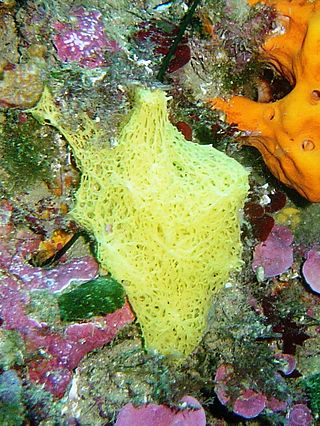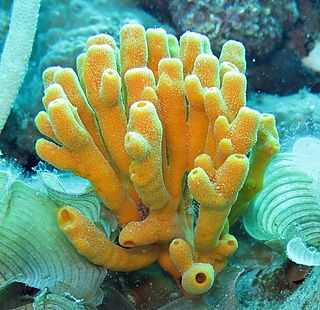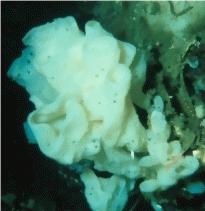
The Clathrinida are an order of calcareous sponges found in marine environments. These sponges have an asconoid structure and lack a true dermal membrane or cortex. The spongocoel is lined with choanocytes.

Homosclerophorida is an order of marine sponges. It is the only order in the monotypic class Homoscleromorpha. The order is composed of two families: Plakinidae and Oscarellidae.
Ascandra izuensis is a species of sea sponge in the family Clathrinidae. The species is named after the Izu peninsula where the holotype was collected.
Clathrina multiformis is a species of calcareous sponge from Russia.
Trichogypsia is a genus of calcareous sponges in the order Baerida.
Thoosa is a genus of sea sponges in the family Thoosidae. This genus is known for boring holes in corals. It contains sixteen described species.

Auletta is a genus of sponges in the family Bubaridae.
Agelas gracilis, commonly known as candy cane sponge, is a species of demosponge. It lives primarily in Australian waters. It has a symbiotic relationship with the white zoanthid making red and white polyps.
Homaxinella is a genus of sea sponges in the family Suberitidae. The type species is Homaxinella balfourensis.
Guancha apicalis was thought to be a species of calcareous sponge in the genus Guancha from Antarctica. It actually never existed.
Cladorhiza caillieti is a carnivorous sponge of the family Cladorhizidae described in 2014 from specimens collected from the Juan de Fuca Ridge off the coast of Vancouver Island. It feeds on small crustaceans such as amphipods and copepods. C. caillieti is an elongate, bottlebrush-shaped sponge with filaments projecting from a main stem, and ranges from 7 to 9 cm in height. The specific epithet honors Dr. Gregor M. Cailliet of the Moss Landing Marine Laboratories.
Clathrina arnesenae is a species of calcareous sponge from the Atlantic Ocean. It is named after Norwegian spongiologist Emily Arnesen (1867–1928).
Clathrina camura is a species of calcareous sponge from the Atlantic Ocean.

Oscarellidae is a family of marine sponges.
Acanthascus is a genus of sponges in the family Rossellidae. Species include:

Verongula is a genus of sea sponges in the family Aplysinidae.

Bubaridae is a family of sponges belonging to the order Bubarida. It has a cosmopolitan distribution.

Pipestela candelabra is a species of sponge belonging to the family Axinellidae.

Atlantisella is a genus of glass sponges (Hexactinellids) belonging to the family Euplectellidae, first described in 2002 by Konstantin Tabachnick.






